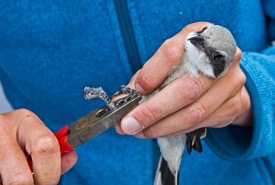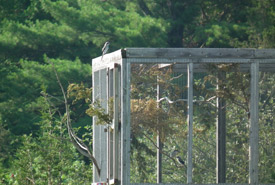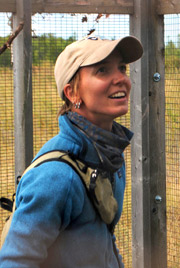Strength in numbers: Captive breeding and release program for shrikes in Ontario

All of the young shrikes are banded with a uniquely-numbered metal band before they are released; most will also get a combination of colour bands so they can be easily identified from a distance in the wild. (Photo by Lydia Dotto, ImageInnovation Photography)
There are only a few places left in Ontario where you can reliably find the endangered loggerhead shrike; one of those places is a property owned by the Nature Conservancy of Canada (NCC). NCC’s Scheck Nature Reserve, located northeast of Napanee in Ontario, is a special place for shrikes.
For one, it’s been a nesting site for loggerhead shrikes almost every year since Canadian researchers started paying attention to the birds back in 1991. Shrikes do tend to use the same nesting sites year after year, so the extended use of this area for breeding isn’t surprising. However, as the amount of habitat on the landscape dwindles, so does the number of long-term nesting sites in Ontario. Thus the protection afforded to this habitat by NCC has become all the more important.
The Scheck Nature Reserve is also special for Ontario’s loggerhead shrikes because it holds two birdcages, but these are not your typical cages. These are large outdoor enclosures made up of three cages, each of which stand 10 feet tall, eight feet wide and at least 12 feet long, and they are the staging grounds for the release of young captive-bred shrikes.
These birds are hatched at one of four partner facilities: the Toronto Zoo, African Lion Safari, Mounstberg Raptor Centre or the Smithsonian Conservation Biology Institute in Virginia. Once they’re about 40 days old and are independent from their parents, they are moved to the cages at one of the release sites, of which there are two in Ontario: the Scheck Nature Reserve and another on Couchiching Conservancy land on the Carden Alvar near Orillia.
The birds will stay in these cages for one or two weeks, during which time they will grow accustomed to their new surroundings, including what kind of predators may be around. This time also allows staff who are feeding the birds to make sure that they are healthy, fit and able to feed themselves. A program like this is only as good as the health of the birds it produces, after all.

A young captive-bred loggerhead shrike tastes freedom as it leaves the release cage for the first time. Two other birds can be seen just inside the opened door, contemplating their next move. (Photo by Emily Bird)
Captive-breeding and release is an important part of loggerhead shrike recovery efforts in Ontario, which have been coordinated by Wildlife Preservation Canada (WPC) since 2003. Along with wild population monitoring, public education, habitat stewardship and protection, captive-breeding rounds out of the intensive efforts of WPC and partner organizations to prevent the birds from disappearing from the province altogether.
This year, fewer than 40 loggerhead shrikes were found in Ontario, and almost one quarter of those were captive-bred birds that had been released in past years. These are shocking numbers, but they show the importance of the release of captive-bred young in bolstering the population of birds in the wild while we figure out the main drivers behind the shrinking shrike numbers, and how to stop them from continuing to shrink.
The mystery of the disappearing birds
So what is driving these declines? As with most species at risk, there’s the usual range of suspects: predation, car collisions, pesticides, extreme and erratic weather caused by climate change and habitat loss. Much as it would be easier if there were one thing we could point our finger at and say, "This! This is the problem!" the reality is that it’s more likely a combination of a number of these things that’s causing the birds to disappear.
What’s more, the problem extends south of the Ontario border, where our shrikes spend the winter, making things a bit more complicated. Fortunately, the interest in loggerhead shrike conservation is growing in the eastern States, so new partnerships that are flourishing in the U.S. can help to examine the things that are affecting our shrikes year-round.
Until we can get to solid answers though, we rely on the captive-breeding and release program to help sustain the population. More than 800 young shrikes have been released since the program started in the early 2000s, and over 150 of those passed through the cages on the Scheck Nature Reserve since it became a release site in 2012.
Not all of these birds have made it, of course; the life of a migratory bird is a tough one, and rife with danger. However, we’ve seen a number of these birds return to breed in subsequent years, and they have in turn contributed more young birds to the shrike population.
There is strength in numbers, so each new baby we see, whether wild or captive-bred, means just a little bit more hope for the future of these birds in Ontario.


